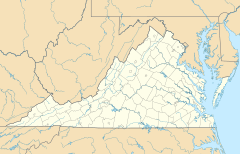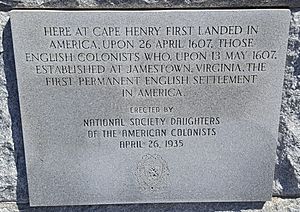First Landing State Park facts for kids
Quick facts for kids First Landing State Park |
|
|---|---|
|
IUCN Category III (Natural Monument)
|
|

Cypress swamp at First Landing State Park
|
|
| Location | Virginia Beach, Virginia, USA |
| Area | 2,888 acres (11.69 km2) |
| Visitors | 1,000,000+ (in 2004) |
| Governing body | Virginia Department of Conservation and Recreation |
First Landing State Park is a super cool place to visit in Virginia Beach, Virginia. It used to be called Seashore State Park. This park is really special because it was the very first state park planned in Virginia! It's even listed on the National Register of Historic Places as a historic district. Part of the park is also a National Natural Landmark, which means it has important natural features.
This park is close to where the first English colonists landed in Virginia on April 26, 1607. These colonists, led by Christopher Newport and the Virginia Company, landed here before they went on to build Jamestown.
First Landing State Park is Virginia's most popular state park, with over a million visitors every year! You can do lots of fun things here, like camping, fishing, and swimming. There's a public beach and over 19 miles (30 km) of trails for hiking and biking. The park also has cozy cabins you can rent. You'll find the main entrance on Shore Drive. Just remember, there's a fee for camping and staying in the cabins.
The park was built in the 1930s by a group called the Civilian Conservation Corps. It's located right on the Chesapeake Bay. The park covers about 2,888 acres (11.69 km²) and offers many activities. Besides hiking and biking, you can go boating, enjoy nature and history programs, and have picnics. There are even campsites with water and electricity, plus restrooms and showers nearby. The park's name was changed in 1997 to First Landing State Park to remember that important first landing.
Park History
Work on what was then called Seashore State Park started in 1933. The Civilian Conservation Corps (CCC) helped build it. The CCC was a program during the Great Depression that gave jobs to young men. Most of the workers here were African American men. They built the park on about 1,060 acres (4.29 km²) of land that was given to the state.
The new park officially opened on June 15, 1936. Over the years, more land was added, and the park's size grew to its current 2,888 acres (11.69 km²).
In 1965, a special part of the park, called the Seashore Natural Area, was named a National Natural Landmark. This was because of its unique forests, sand dunes, and plants that grow in warm, wet areas. In 1997, the park's name changed from Seashore State Park to First Landing State Park. This new name helps everyone remember the important historical event of the first English colonists landing there.
To mark the spot where the colonists first landed, a cross was put up in the park on April 26, 1935. This was done by a group called the Daughters of the American Colonists. There's also a sign at the base of the cross that tells about the landing and the founding of Jamestown.
Park Buildings and Design
|
Seashore State Park Historic District
|
|

A cabin in the park
|
|
| Location | 2500 Shore Dr., Virginia Beach, Virginia |
|---|---|
| Area | 2,889 acres (11.69 km2) |
| Built | 1933 |
| Built by | CEGG Assoc. LC; NPS, et al. |
| Architectural style | Modern Movement |
| NRHP reference No. | 05001267 |
| Significant dates | |
| Added to NRHP | November 16, 2005 |
The entire First Landing State Park is considered a historic district. This means its buildings and design are important to history, especially from 1933. It includes many original buildings, sites, and structures.
First Landing was the very first state park planned for Virginia. Its design was created with a lot of help from the National Park Service. They provided drawings and plans. They also shared ideas about how to make roads and other parts of the park work well, based on their experience with national parks.
The actual work of building the roads, cabins, and other features was done by the Civilian Conservation Corps (CCC) workers. These workers lived in three camps, with 200 men in each camp, while they built the park.
Images for kids






